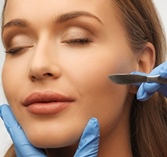
The professional beauty industry has a notoriously difficult relationship with shaving. Every esthetician worth their waxing strips will tell you that shaving is one of the least effective methods of hair removal and encourages strands to grow back faster and thicker. It’s because of this commonly held view that the latest hair removal trend is so baffling.
Dermaplaning appeared on our radar in May last year when beauty vlogger Chloe Morello told her 1.7 million YouTube subscribers that she shaved her face.
“Sometimes I find that my foundation doesn’t look perfectly fine or even if I have a lot of hair on my face. I am a woman but it runs in my family to have severe peach fuzz on the lower half of my face. So I actually shave my face,” she said in the 2016 video.
“I know that it’s a trend happening now, but I’m totally on the bandwagon because it makes a huge difference when applying your makeup.”
The method has been dubbed as dermaplaning and involves gently removing the outermost layer of dead skin and vellus hair, or ‘peach fuzz’ as it’s commonly known. Morello isn’t the only one who’s all for it too – hugely popular beauty vloggers Huda Beauty and Carli Bybel recommend it, while beauty book author Zoe Foster Blake recently came out in support of the treatment as well.
“Dermaplaning (around $100) is exfoliating, brightening, skin-tone-evening, non-inflammatory (so: great for pigmentation sufferes [sic]), helps skincare penetrate better, and makes your skin freakishly smooth (because, um, it’s hairless), meaning your make-up will sit PERFECTLY,” she wrote in an April 13th Instagram post.
Foster had the treatment at Me Skin & Body in Melbourne’s South Yarra, where a scalpel (normally a 10-gauge) used small upward strokes to remove the dead layer of skin and hair.
Like most trends, the likelihood that our clients will start asking for it is high, so the question begs – should dermaplaning be on your salon menu?
Let’s cover the most obvious question first – does dermaplaning cause stubble?
While shaving some parts of the body can be averse in the long run, shaving facial hair off while dermaplaning won’t have this effect. UK-based paper The Telegraph interviewed three senior skincare experts on the issue and the consensus was dermaplaning will not encourage hair growth.

“There’s no scientific evidence to back up the belief that hair grows back darker and thicker anywhere on the body after shaving,” Saira Chaudhary, a Senior therapist at HB Health of Knightsbridge told the publication. “The hair-shaft will no doubt feel more coarse, as it’s been cut, but that’s just a case of texture, rather than density and pigment; it’s not actually thicker.”
Kate Somerville, Skincare expert commented, “My clients get nervous that hair will grow back thicker, but it won’t – that’s an old wives’ tale. Hormones are the only things that change hair growth. I recommend shaving once a week. You shouldn’t experience ingrown hairs on the face either, as hair is much finer there than on the body.”
Dr. Sam Bunting, a Cosmetic dermatologist also quoted in the article, agreed. “Dermaplaning as a cosmetic procedure is simply another form of exfoliation. Shaving certainly doesn’t affect the regrowth, nor does it make hair anywhere on the face or body come back thicker or darker.”
Now that we know we’re not going to leave our clients with an five o’clock shadow, the growing demand behind dermaplaning is making more sense.

As both Chloe Morello and Zoe Foster Blake noted, the treatment leaves skin incredibly smooth, soft and ideal for applying makeup. One of the main reasons dermaplaning followers cite is that the process encourages a deeper and more even exfoliation process and promotes the productions of collagen and elastin.
Recipients have also commented on a significantly even colour visage after the treatment, both in texture and colour, while the removal of the top layer of skin makes the application of topical products more effective.
Essentially, dermaplaning gives salons the opportunity to immediately brighten, smooth and revitalise client’s skin, providing them with real, fast and tangible results.
Have your say – are you considering adding dermaplaning to your salon menu?
Related:
- You’ll never clean your brushes yourself again after reading this
- This nail trend is taking over Instagram
- Laser Clinics Australia opens 80th clinic
- Six things we all wished our clients knew before a wax
- What you need to know about waxing this year

